Serum Uric Acid is Associated with Renal Prognosis of Lupus Nephritis in Women but not in Men
Abstract
1. Introduction
2. Materials and Methods
2.1. Data Sources and Study Population
2.2. Study End-Point, Definitions, and Measurements
2.3. Statistical Analyses
2.4. Ethical Approval and Informed Consent
3. Results
3.1. Clinical Characteristics of the Study Population
3.2. Crude Analysis of the Association between Serum Uric Acid Levels and Progression of Lupus Nephritis
3.3. Independent Risk Factors Associated with the Progression of Lupus Nephritis
4. Discussion
5. Conclusions
Author Contributions
Funding
Acknowledgments
Conflicts of Interest
References
- Ames, B.N.; Cathcart, R.; Schwiers, E.; Hochstein, P. Uric acid provides an antioxidant defense in humans against oxidant- and radical-caused aging and cancer: A hypothesis. Proc. Natl. Acad. Sci. USA 1981, 78, 6858–6862. [Google Scholar] [CrossRef]
- Shi, Y.; Evans, J.E.; Rock, K.L. Molecular identification of a danger signal that alerts the immune system to dying cells. Nature 2003, 425, 516–521. [Google Scholar] [CrossRef]
- Mazzali, M.; Hughes, J.; Kim, Y.G.; Jefferson, J.A.; Kang, D.H.; Gordon, K.L.; Lan, H.Y.; Kivlighn, S.; Johnson, R.J. Elevated uric acid increases blood pressure in the rat by a novel crystal-independent mechanism. Hypertension (Dallas, Tex. 1979) 2001, 38, 1101–1106. [Google Scholar] [CrossRef]
- Feig, D.I.; Kang, D.H.; Johnson, R.J. Uric acid and cardiovascular risk. New Engl. J. Med. 2008, 359, 1811–1821. [Google Scholar] [CrossRef]
- Srivastava, A.; Kaze, A.D.; McMullan, C.J.; Isakova, T.; Waikar, S.S. Uric Acid and the Risks of Kidney Failure and Death in Individuals With CKD. Am. J. Kidney Dis. Off. J. Natl. Kidney Found. 2018, 71, 362–370. [Google Scholar] [CrossRef]
- Jeong, H.Y.; Cho, H.J.; Kim, S.H.; Kim, J.C.; Lee, M.J.; Yang, D.H.; Lee, S.Y. Erratum: Association of serum uric acid level with coronary artery stenosis severity in Korean end-stage renal disease patients [Volume 36, Issue 3, September 2017, Pages 282–289]. Kidney Res. Clin. Pract. 2018, 37, 180. [Google Scholar] [CrossRef] [PubMed]
- Syrjanen, J.; Mustonen, J.; Pasternack, A. Hypertriglyceridaemia and hyperuricaemia are risk factors for progression of IgA nephropathy. Nephrol. Dial. Transplant. Off. Publ. Eur. Dial. Transpl. Assoc. Eur. Ren. Assoc. 2000, 15, 34–42. [Google Scholar] [CrossRef] [PubMed]
- Bakan, A.; Oral, A.; Elcioglu, O.C.; Takir, M.; Kostek, O.; Ozkok, A.; Basci, S.; Sumnu, A.; Ozturk, S.; Sipahioglu, M.; et al. Hyperuricemia is associated with progression of IgA nephropathy. Int. Urol. Nephrol. 2015, 47, 673–678. [Google Scholar] [CrossRef] [PubMed]
- Bomback, A.S.; Appel, G.B. Updates on the treatment of lupus nephritis. J. Am. Soc. Nephrol. Jasn 2010, 21, 2028–2035. [Google Scholar] [CrossRef] [PubMed]
- Walters, B.A.; Hays, R.D.; Spritzer, K.L.; Fridman, M.; Carter, W.B. Health-related quality of life, depressive symptoms, anemia, and malnutrition at hemodialysis initiation. Am. J. Kidney Dis. Off. J. Natl. Kidney Found. 2002, 40, 1185–1194. [Google Scholar] [CrossRef]
- Esdaile, J.M.; Joseph, L.; MacKenzie, T.; Kashgarian, M.; Hayslett, J.P. The benefit of early treatment with immunosuppressive drugs in lupus nephritis. J. Rheumatol. 1995, 22, 1211. [Google Scholar] [PubMed]
- Sheikh, M.; Movassaghi, S.; Khaledi, M.; Moghaddassi, M. [Hyperuricemia in systemic lupus erythematosus: Is it associated with the neuropsychiatric manifestations of the disease?]. Rev. Bras. De Reumatol. 2015. [Google Scholar] [CrossRef] [PubMed][Green Version]
- Frocht, A.; Leek, J.C.; Robbins, D.L. Gout and hyperuricaemia in systemic lupus erythematosus. Br. J. Rheumatol. 1987, 26, 303–306. [Google Scholar] [CrossRef] [PubMed]
- Liu, S.; Gong, Y.; Ren, H.; Zhang, W.; Chen, X.; Zhou, T.; Li, X.; Chen, N. The prevalence, subtypes and associated factors of hyperuricemia in lupus nephritis patients at chronic kidney disease stages 1–3. Oncotarget 2017, 8, 57099–57108. [Google Scholar] [CrossRef] [PubMed]
- Stubnova, V.; Os, I.; Høieggen, A.; Solbu, M.D.; Grundtvig, M.; Westheim, A.S.; Atar, D.; Waldum-Grevbo, B. Gender differences in association between uric acid and all-cause mortality in patients with chronic heart failure. Bmc Cardiovasc. Disord. 2019, 19, 4. [Google Scholar] [CrossRef] [PubMed]
- Yoshitomi, R.; Fukui, A.; Nakayama, M.; Ura, Y.; Ikeda, H.; Oniki, H.; Tsuchihashi, T.; Tsuruya, K.; Kitazono, T. Sex differences in the association between serum uric acid levels and cardiac hypertrophy in patients with chronic kidney disease. Hypertens. Res. Off. J. Jpn. Soc. Hypertens. 2014, 37, 246–252. [Google Scholar] [CrossRef]
- Chen, L.H.; Zhong, C.; Xu, T.; Xu, T.; Peng, Y.; Wang, A.; Wang, J.; Peng, H.; Li, Q.; Ju, Z.; et al. Sex-specific Association Between Uric Acid and Outcomes After Acute Ischemic Stroke: A Prospective Study from CATIS Trial. Sci. Rep. 2016, 6, 38351. [Google Scholar] [CrossRef]
- Nagasawa, Y.; Yamamoto, R.; Shoji, T.; Shinzawa, M.; Hasuike, Y.; Nagatoya, K.; Yamauchi, A.; Hayashi, T.; Kuragano, T.; Moriyama, T.; et al. Serum Uric Acid Level Predicts Progression of IgA Nephropathy in Females but Not in Males. PLoS ONE 2016, 11, e0160828. [Google Scholar] [CrossRef]
- Ju, J.H.; Yoon, S.H.; Kang, K.Y.; Kim, I.J.; Kwok, S.K.; Park, S.H.; Kim, H.Y.; Lee, W.C.; Cho, C.S. Prevalence of systemic lupus erythematosus in South Korea: An administrative database study. J. Epidemiol. 2014, 24, 295–303. [Google Scholar] [CrossRef]
- Madley-Dowd, P.; Hughes, R.; Tilling, K.; Heron, J. The proportion of missing data should not be used to guide decisions on multiple imputation. J. Clin. Epidemiol. 2019, 110, 63–73. [Google Scholar] [CrossRef]
- Van Buuren, S.; Groothuis-Oudshoorn, K. mice: Multivariate Imputation by Chained Equations in R. J. Stat. Softw. 2011, 45, 67. [Google Scholar] [CrossRef]
- Pedersen, A.B.; Mikkelsen, E.M.; Cronin-Fenton, D.; Kristensen, N.R.; Pham, T.M.; Pedersen, L.; Petersen, I. Missing data and multiple imputation in clinical epidemiological research. Clin. Epidemiol. 2017, 9, 157–166. [Google Scholar] [CrossRef] [PubMed]
- Team, R.C. R: A Language and Environment for Statistical Computing. Available online: http://www.R-project.org/} (accessed on 15 January 2020).
- Hooper, D.C.; Spitsin, S.; Kean, R.B.; Champion, J.M.; Dickson, G.M.; Chaudhry, I.; Koprowski, H. Uric acid, a natural scavenger of peroxynitrite, in experimental allergic encephalomyelitis and multiple sclerosis. Proc. Natl. Acad. Sci. USA 1998, 95, 675–680. [Google Scholar] [CrossRef] [PubMed]
- Justicia, C.; Salas-Perdomo, A.; Perez-de-Puig, I.; Deddens, L.H.; Van Tilborg, G.A.F.; Castellvi, C.; Dijkhuizen, R.M.; Chamorro, A.; Planas, A.M. Uric Acid Is Protective After Cerebral Ischemia/Reperfusion in Hyperglycemic Mice. Transl. Stroke Res. 2017, 8, 294–305. [Google Scholar] [CrossRef] [PubMed]
- Lanaspa, M.A.; Sanchez-Lozada, L.G.; Choi, Y.J.; Cicerchi, C.; Kanbay, M.; Roncal-Jimenez, C.A.; Ishimoto, T.; Li, N.; Marek, G.; Duranay, M.; et al. Uric acid induces hepatic steatosis by generation of mitochondrial oxidative stress: Potential role in fructose-dependent and -independent fatty liver. J. Biol. Chem. 2012, 287, 40732–40744. [Google Scholar] [CrossRef]
- Kang, D.H.; Nakagawa, T.; Feng, L.; Watanabe, S.; Han, L.; Mazzali, M.; Truong, L.; Harris, R.; Johnson, R.J. A role for uric acid in the progression of renal disease. J. Am. Soc. Nephrol. Jasn 2002, 13, 2888–2897. [Google Scholar] [CrossRef]
- Roncal, C.A.; Mu, W.; Croker, B.; Reungjui, S.; Ouyang, X.; Tabah-Fisch, I.; Johnson, R.J.; Ejaz, A.A. Effect of elevated serum uric acid on cisplatin-induced acute renal failure. Am. J. Physiol. Ren. Physiol. 2007, 292, F116–F122. [Google Scholar] [CrossRef]
- Ejaz, A.A.; Mu, W.; Kang, D.H.; Roncal, C.; Sautin, Y.Y.; Henderson, G.; Tabah-Fisch, I.; Keller, B.; Beaver, T.M.; Nakagawa, T.; et al. Could uric acid have a role in acute renal failure? Clin. J. Am. Soc. Nephrol. Cjasn 2007, 2, 16–21. [Google Scholar] [CrossRef]
- Giclas, P.C.; Ginsberg, M.H.; Cooper, N.R. Immunoglobulin G independent activation of the classical complement pathway by monosodium urate crystals. J. Clin. Investig. 1979, 63, 759–764. [Google Scholar] [CrossRef]
- Yang, Z.; Liang, Y.; Xi, W.; Zhu, Y.; Li, C.; Zhong, R. Association of serum uric acid with lupus nephritis in systemic lupus erythematosus. Rheumatol. Int. 2011, 31, 743–748. [Google Scholar] [CrossRef]
- Barbieri, L.; Verdoia, M.; Schaffer, A.; Marino, P.; Suryapranata, H.; De Luca, G. Impact of sexon uric acid levels and its relationship with the extent of coronary artery disease: A single-centre study. Atherosclerosis 2015, 241, 241–248. [Google Scholar] [CrossRef]
- Sun, Y.; Zhang, H.; Tian, W.; Shi, L.; Chen, L.; Li, J.; Zhao, S.; Qi, G. Association between serum uric acid levels and coronary artery disease in different age and gender: A cross-sectional study. Aging Clin. Exp. Res. 2019, 31, 1783–1790. [Google Scholar] [CrossRef] [PubMed]
- Takiue, Y.; Hosoyamada, M.; Kimura, M.; Saito, H. The effect of female hormones upon urate transport systems in the mouse kidney. Nucleosides Nucleic Acids 2011, 30, 113–119. [Google Scholar] [CrossRef] [PubMed]
- Prasad, M.; Matteson, E.L.; Herrmann, J.; Gulati, R.; Rihal, C.S.; Lerman, L.O.; Lerman, A. UricAcid Is Associated With Inflammation, Coronary Microvascular Dysfunction, and Adverse Outcomes in Postmenopausal Women. Hypertension (Dallas, Tex. 1979) 2017, 69, 236–242. [Google Scholar] [CrossRef] [PubMed]
- Sciacqua, A.; Perticone, M.; Tassone, E.J.; Cimellaro, A.; Miceli, S.; Maio, R.; Sesti, G.; Perticone, F. Uric acid is an independent predictor of cardiovascular events in post-menopausal women. Int. J. Cardiol. 2015, 197, 271–275. [Google Scholar] [CrossRef] [PubMed]
- Hak, A.E.; Choi, H.K. Menopause, postmenopausal hormone use and serum uric acid levels in US women—The Third National Health and Nutrition Examination Survey. Arthritis Res. Ther. 2008, 10, R116. [Google Scholar] [CrossRef] [PubMed]
- Kohagura, K.; Kochi, M.; Miyagi, T.; Kinjyo, T.; Maehara, Y.; Nagahama, K.; Sakima, A.; Iseki, K.; Ohya, Y. An association between uric acid levels and renal arteriolopathy in chronic kidney disease: A biopsy-based study. Hypertens. Res. Off. J. Jpn. Soc. Hypertens. 2013, 36, 43–49. [Google Scholar] [CrossRef] [PubMed]
- Doring, A.; Gieger, C.; Mehta, D.; Gohlke, H.; Prokisch, H.; Coassin, S.; Fischer, G.; Henke, K.; Klopp, N.; Kronenberg, F.; et al. SLC2A9 influences uric acid concentrations with pronounced sex-specific effects. Nat. Genet. 2008, 40, 430–436. [Google Scholar] [CrossRef] [PubMed]
- Vitart, V.; Rudan, I.; Hayward, C.; Gray, N.K.; Floyd, J.; Palmer, C.N.; Knott, S.A.; Kolcic, I.; Polasek, O.; Graessler, J.; et al. SLC2A9 is a newly identified urate transporter influencing serum urate concentration, urate excretion and gout. Nat. Genet. 2008, 40, 437–442. [Google Scholar] [CrossRef]
- Li, S.; Sanna, S.; Maschio, A.; Busonero, F.; Usala, G.; Mulas, A.; Lai, S.; Dei, M.; Orru, M.; Albai, G.; et al. The GLUT9 gene is associated with serum uric acid levels in Sardinia and Chianti cohorts. PLoS Genet. 2007, 3, e194. [Google Scholar] [CrossRef]
- Caulfield, M.J.; Munroe, P.B.; O’Neill, D.; Witkowska, K.; Charchar, F.J.; Doblado, M.; Evans, S.; Eyheramendy, S.; Onipinla, A.; Howard, P.; et al. SLC2A9 is a high-capacity urate transporter in humans. Plos Med. 2008, 5, e197. [Google Scholar] [CrossRef]
- Greene, T. Randomized and observational studies in nephrology: How strong is the evidence? Am. J. Kidney Dis. Off. J. Natl. Kidney Found. 2009, 53, 377–388. [Google Scholar] [CrossRef] [PubMed]
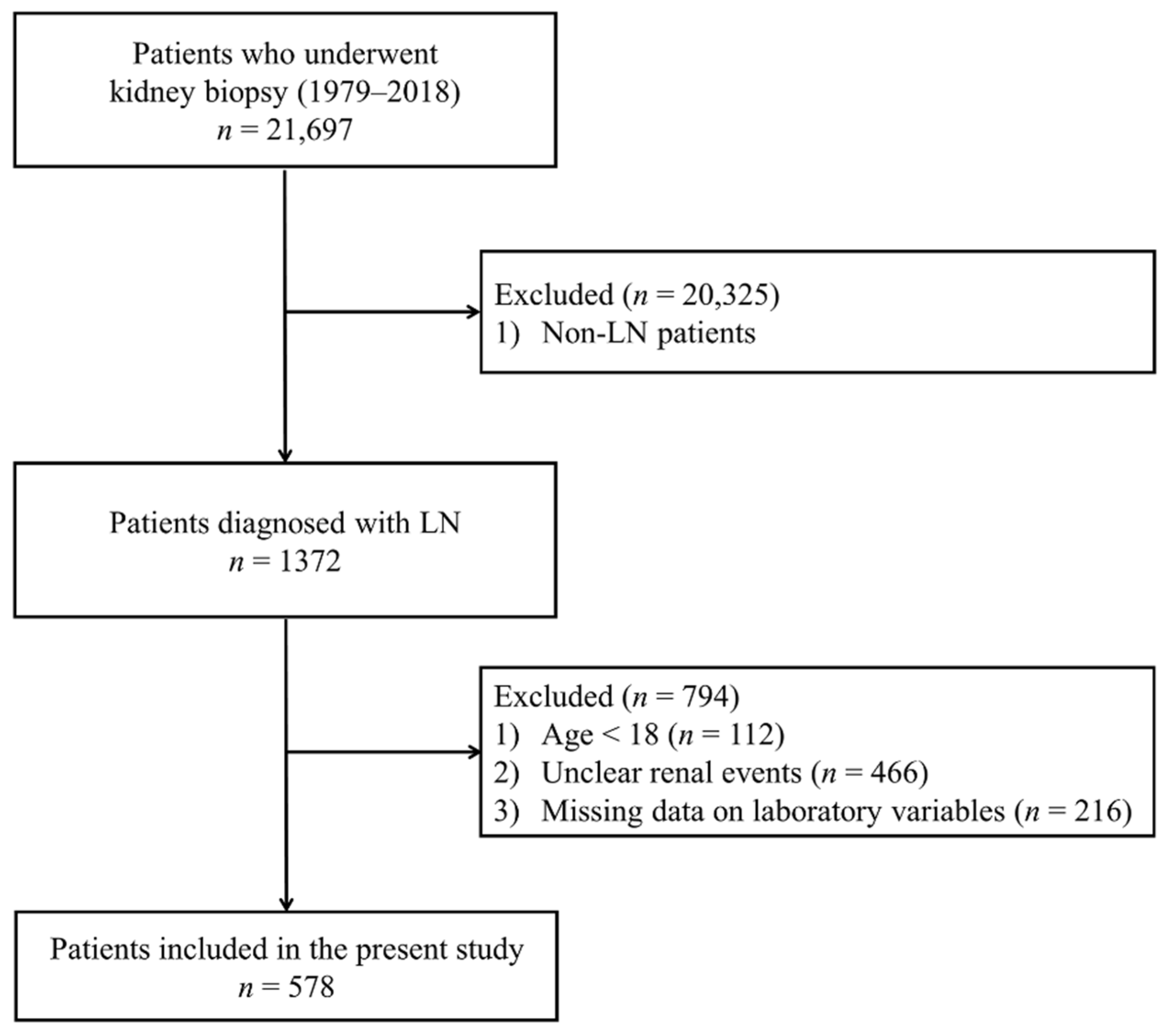
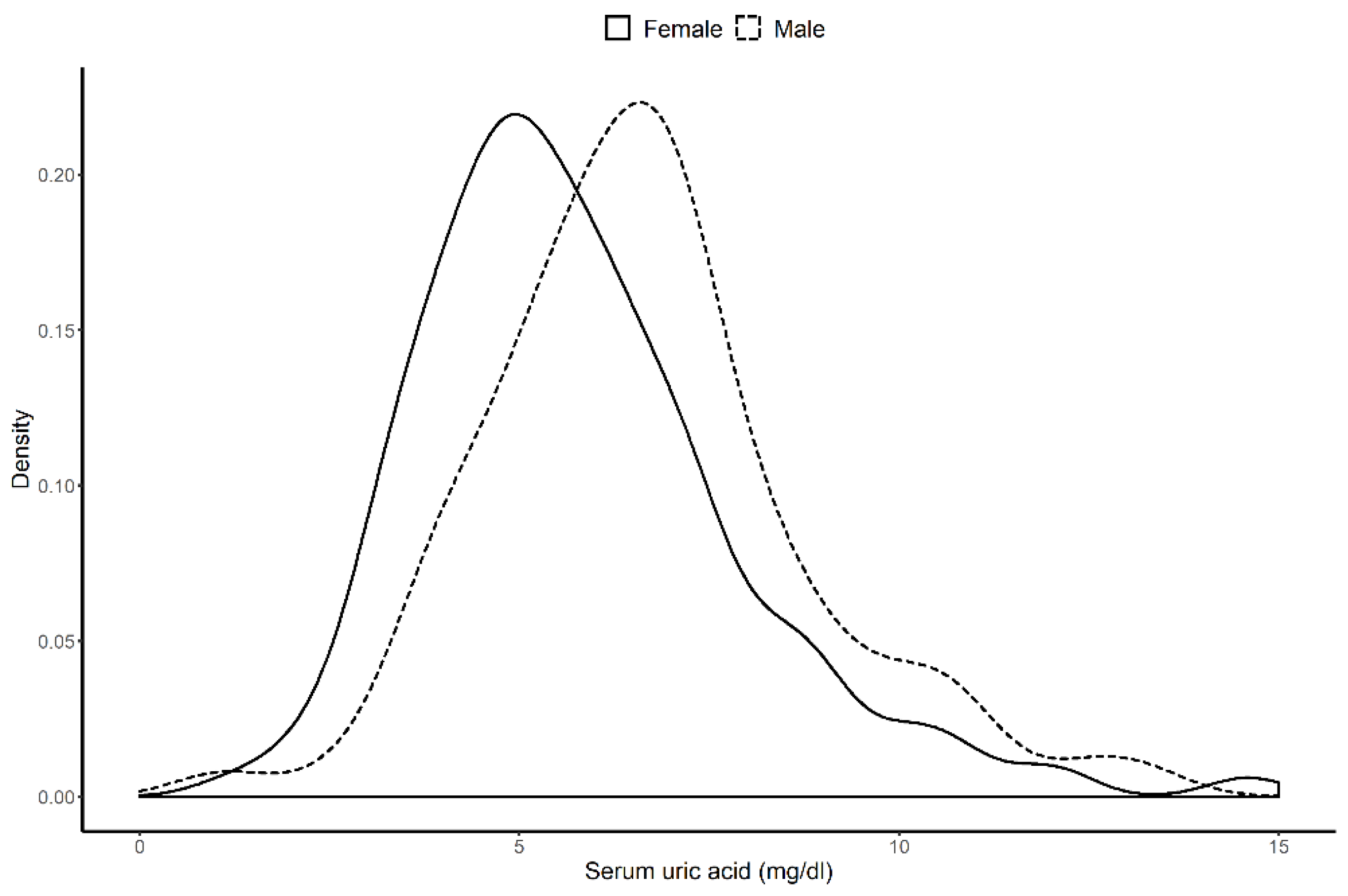
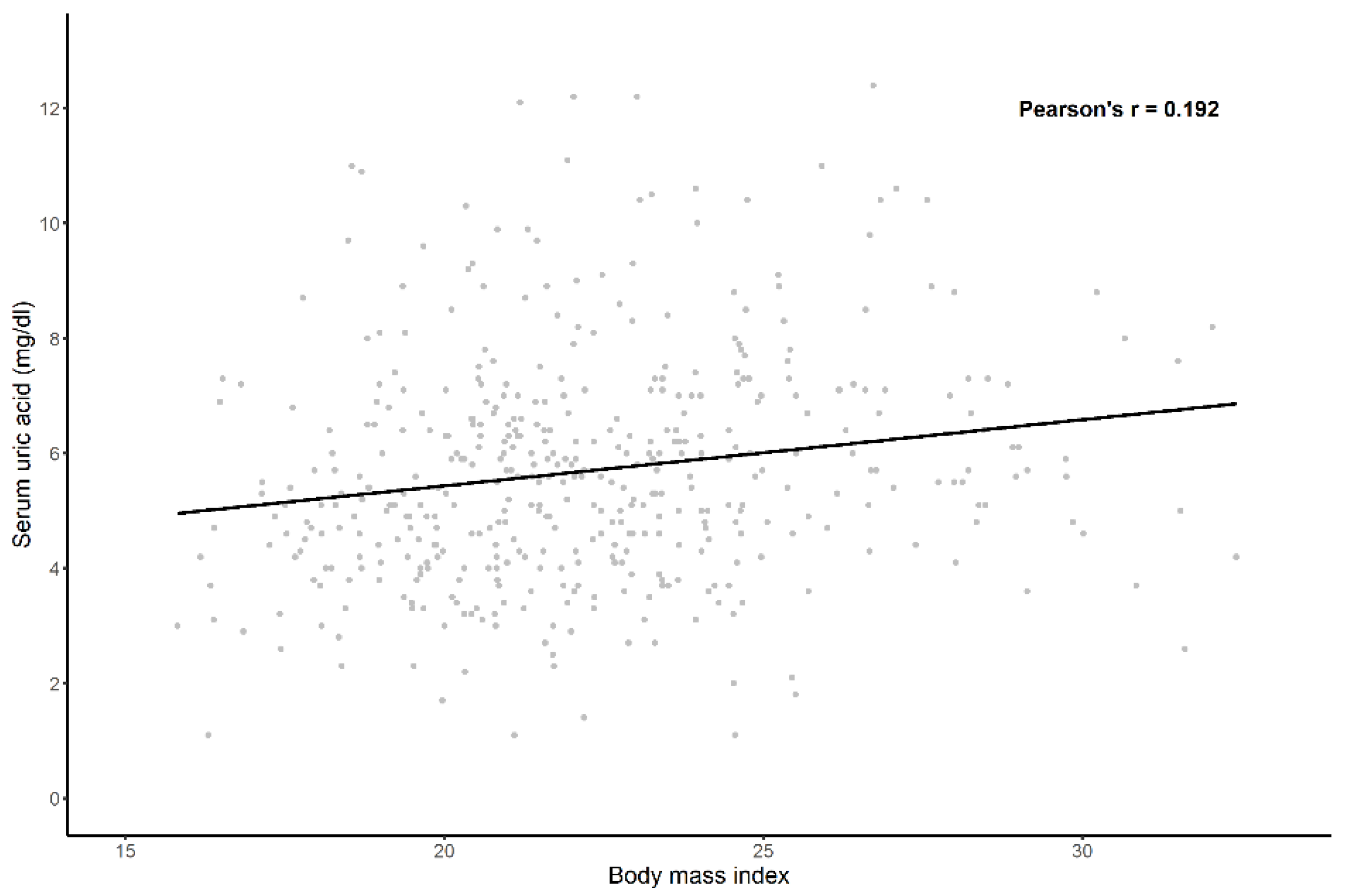

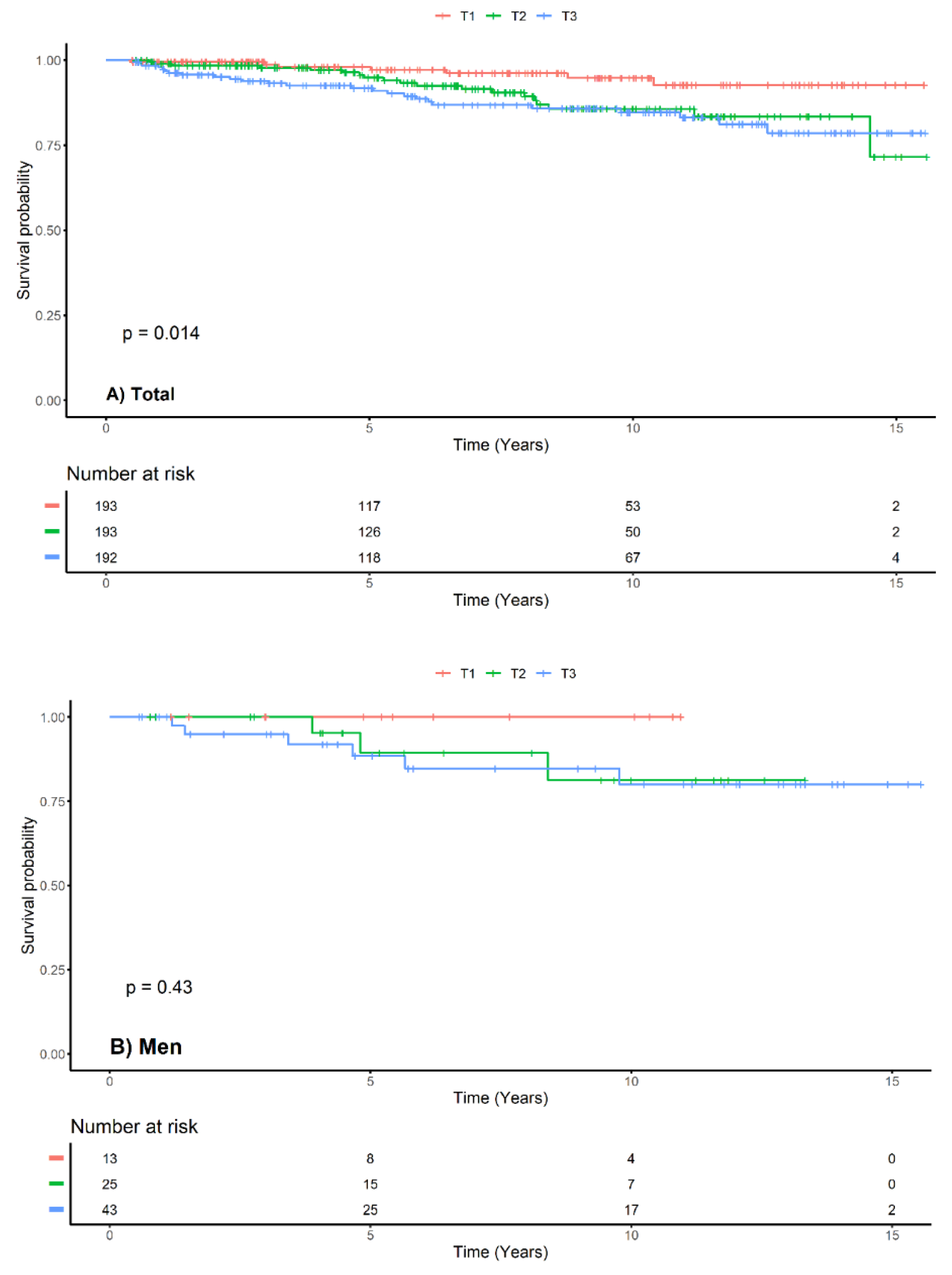
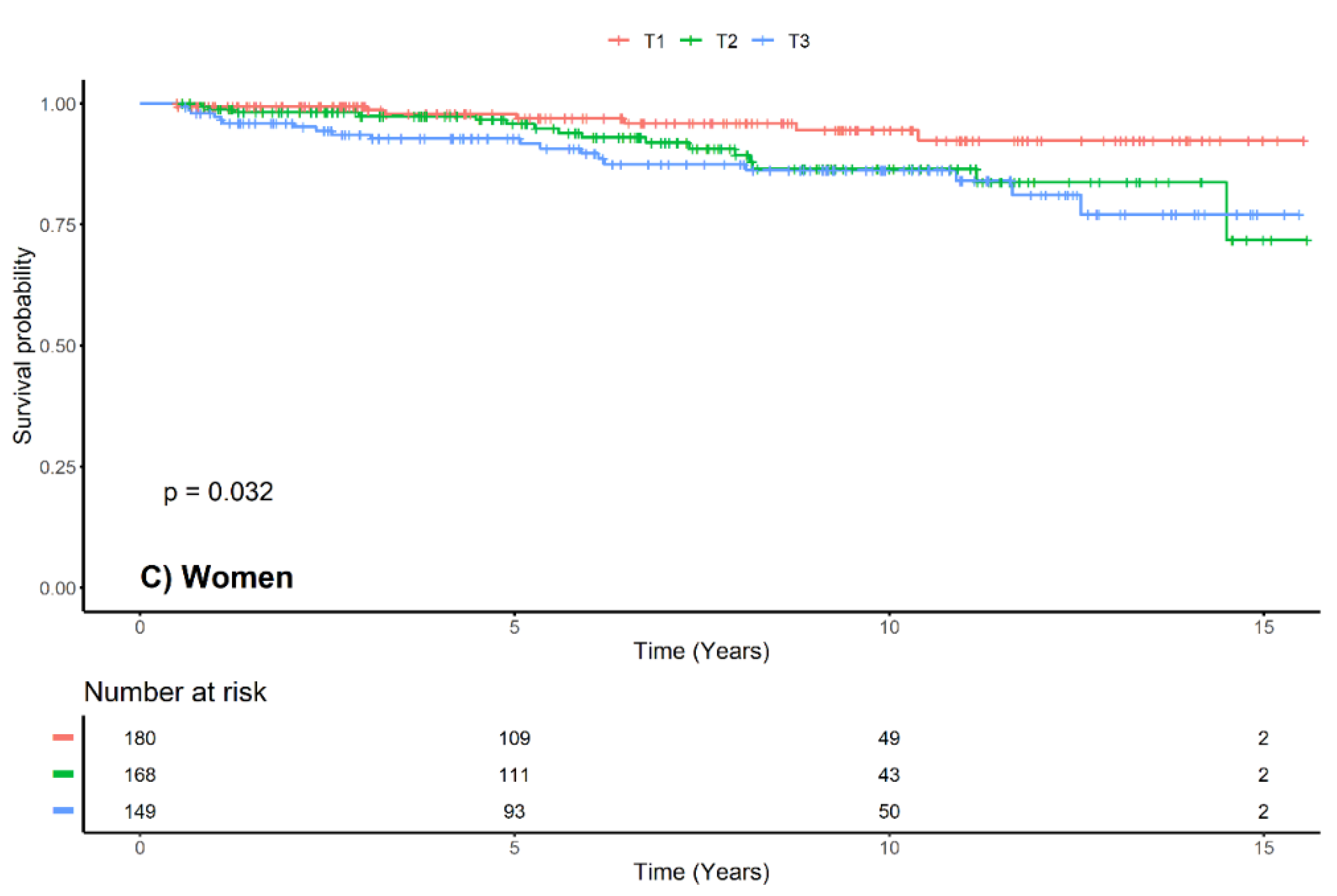
| Characteristics | All Subjects (n = 578) | Control (n = 362) | Hyperuricemia (n = 216) | p-Value |
|---|---|---|---|---|
| Age (year) | 35.7 ± 12.3 | 35.58 ± 11.70 | 35.91 ± 13.15 | 0.786 |
| Men (%) | 81 (14.01%) | 51 (14.09%) | 30 (13.89%) | 1.000 |
| Height (cm) | 160.00 [156.00;164.95] | 160.00 [156.00;164.00] | 160.00 [156.00;165.00] | 0.640 |
| Weight (cm) | 57.00 [51.00;63.80] | 56.00 [50.00;62.70] | 58.00 [52.00;65.00] | 0.005 |
| Body mass index | 21.88 [20.09;24.11] | 21.64 [19.72;23.68] | 22.48 [20.64;24.77] | 0.001 |
| Diabetes mellitus (%) | 15 (2.60%) | 8 (2.21%) | 7 (3.24%) | 0.629 |
| Systolic blood pressure (mmHg) | 123.62 ± 17.54 | 120.63 ± 16.43 | 128.64 ± 18.22 | <0.001 |
| Diastolic blood pressure (mmHg) | 77.42 ± 11.66 | 75.46 ± 11.23 | 80.71 ± 11.65 | <0.001 |
| Serum uric acid (mg/dL) | 5.90 ± 2.20 | 4.61 ± 1.10 | 8.06 ± 1.88 | <0.001 |
| Hemoglobin (g/dL) | 10.53 ± 2.04 | 10.75 ± 1.90 | 10.15 ± 2.20 | <0.001 |
| Serum albumin (mg/dL) | 2.89 ± 0.70 | 3.01 ± 0.68 | 2.69 ± 0.69 | <0.001 |
| C3 | 56.60 [37.00;80.30] | 62.00 [42.10;85.40] | 44.45 [31.90;69.65] | <0.001 |
| Anti-dsDNA Ab (u/L) | 33.15 [1.00;180.00] | 23.20 [1.00;147.00] | 50.25 [4.85;210.00] | 0.014 |
| Creatinine (mg/dL) | 0.80 [0.60;1.10] | 0.70 [0.59;0.89] | 1.10 [0.80;1.48] | <0.001 |
| eGFR (ml/min/1.73m2) | 84.39 [59.47;111.62] | 98.45 [76.41;123.37] | 59.97 [43.03;84.30] | <0.001 |
| Total cholesterol (mg/dL) | 196.00 [161.00;236.00] | 183.50 [155.00;222.00] | 222.00 [178.00;267.50] | <0.001 |
| Urine protein creatinine ratio (g/g Creatinine) | 2.35 [1.03;4.73] | 1.99 [0.80;3.85] | 3.55 [1.73;6.69] | <0.001 |
| Follow-up duration (year) | 6.72 [3.03;10.65] | 6.63 [2.98;10.35] | 7.01 [3.26;10.96] | 0.290 |
| Total Subjects | Men | Women | ||||
|---|---|---|---|---|---|---|
| HR [95% CI] | p-Value | HR [95% CI] | p-Value | HR [95% CI] | p-Value | |
| Crude | 1.156 [1.043;1.281] | 0.006 | 1.196 [0.914;1.565] | 0.192 | 1.150 [1.028;1.287] | 0.015 |
| Model 1 | 1.153 [1.040;1.279] | 0.007 | 1.473 [1.058;2.052] | 0.022 | 1.150 [1.027;1.286] | 0.015 |
| Model 2 | 1.154 [1.033;1.289] | 0.012 | 1.410 [0.957;2.078] | 0.082 | 1.151 [1.017;1.303] | 0.026 |
| Model 3 | 1.151 [1.025;1.292] | 0.017 | 1.499 [0.964;2.331] | 0.072 | 1.158 [1.018;1.317] | 0.028 |
© 2020 by the authors. Licensee MDPI, Basel, Switzerland. This article is an open access article distributed under the terms and conditions of the Creative Commons Attribution (CC BY) license (http://creativecommons.org/licenses/by/4.0/).
Share and Cite
Oh, T.R.; Choi, H.S.; Kim, C.S.; Ryu, D.-R.; Park, S.-H.; Ahn, S.Y.; Kim, S.W.; Bae, E.H.; Ma, S.K. Serum Uric Acid is Associated with Renal Prognosis of Lupus Nephritis in Women but not in Men. J. Clin. Med. 2020, 9, 773. https://doi.org/10.3390/jcm9030773
Oh TR, Choi HS, Kim CS, Ryu D-R, Park S-H, Ahn SY, Kim SW, Bae EH, Ma SK. Serum Uric Acid is Associated with Renal Prognosis of Lupus Nephritis in Women but not in Men. Journal of Clinical Medicine. 2020; 9(3):773. https://doi.org/10.3390/jcm9030773
Chicago/Turabian StyleOh, Tae Ryom, Hong Sang Choi, Chang Seong Kim, Dong-Ryeol Ryu, Sun-Hee Park, Shin Young Ahn, Soo Wan Kim, Eun Hui Bae, and Seong Kwon Ma. 2020. "Serum Uric Acid is Associated with Renal Prognosis of Lupus Nephritis in Women but not in Men" Journal of Clinical Medicine 9, no. 3: 773. https://doi.org/10.3390/jcm9030773
APA StyleOh, T. R., Choi, H. S., Kim, C. S., Ryu, D.-R., Park, S.-H., Ahn, S. Y., Kim, S. W., Bae, E. H., & Ma, S. K. (2020). Serum Uric Acid is Associated with Renal Prognosis of Lupus Nephritis in Women but not in Men. Journal of Clinical Medicine, 9(3), 773. https://doi.org/10.3390/jcm9030773





